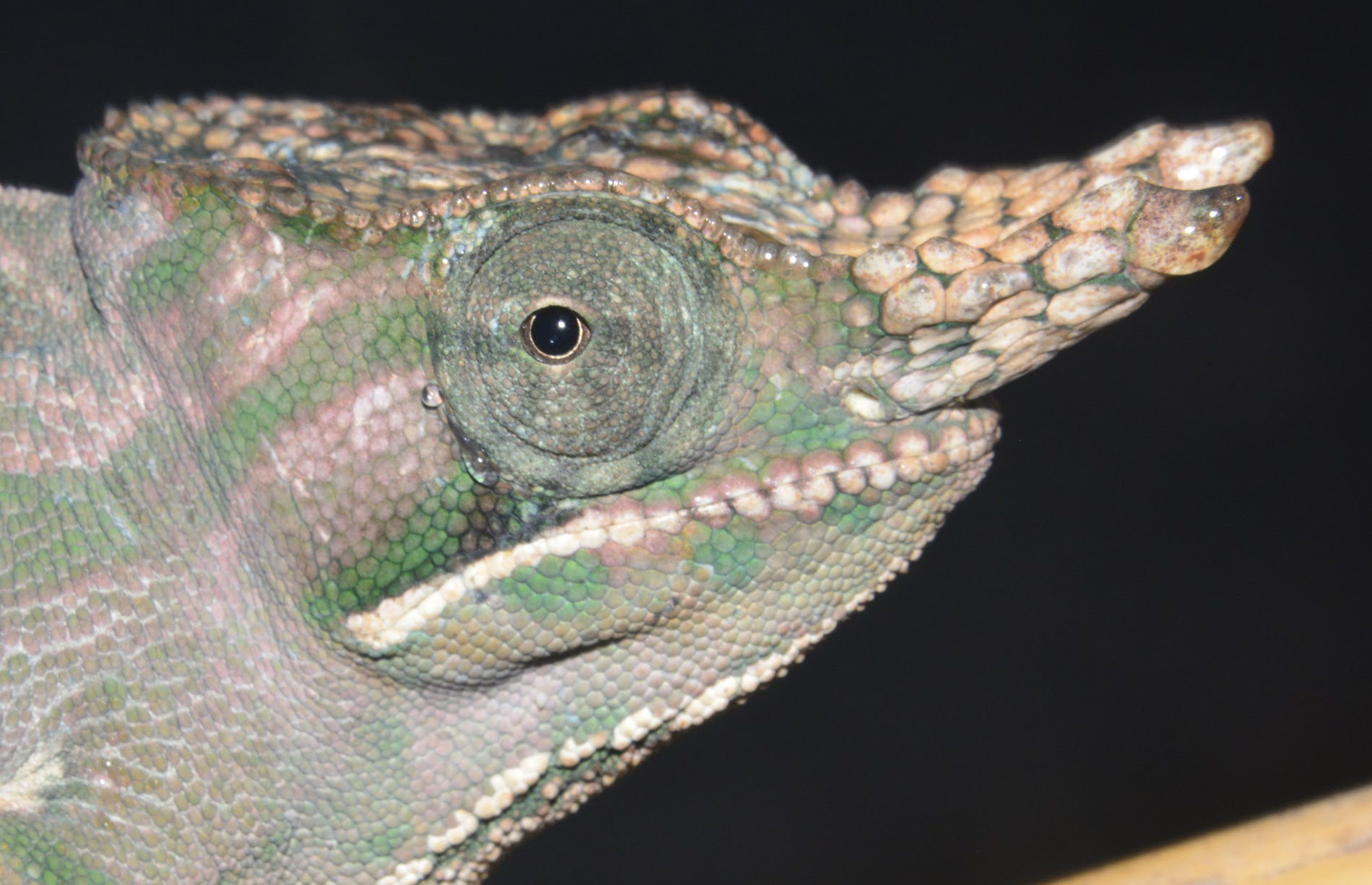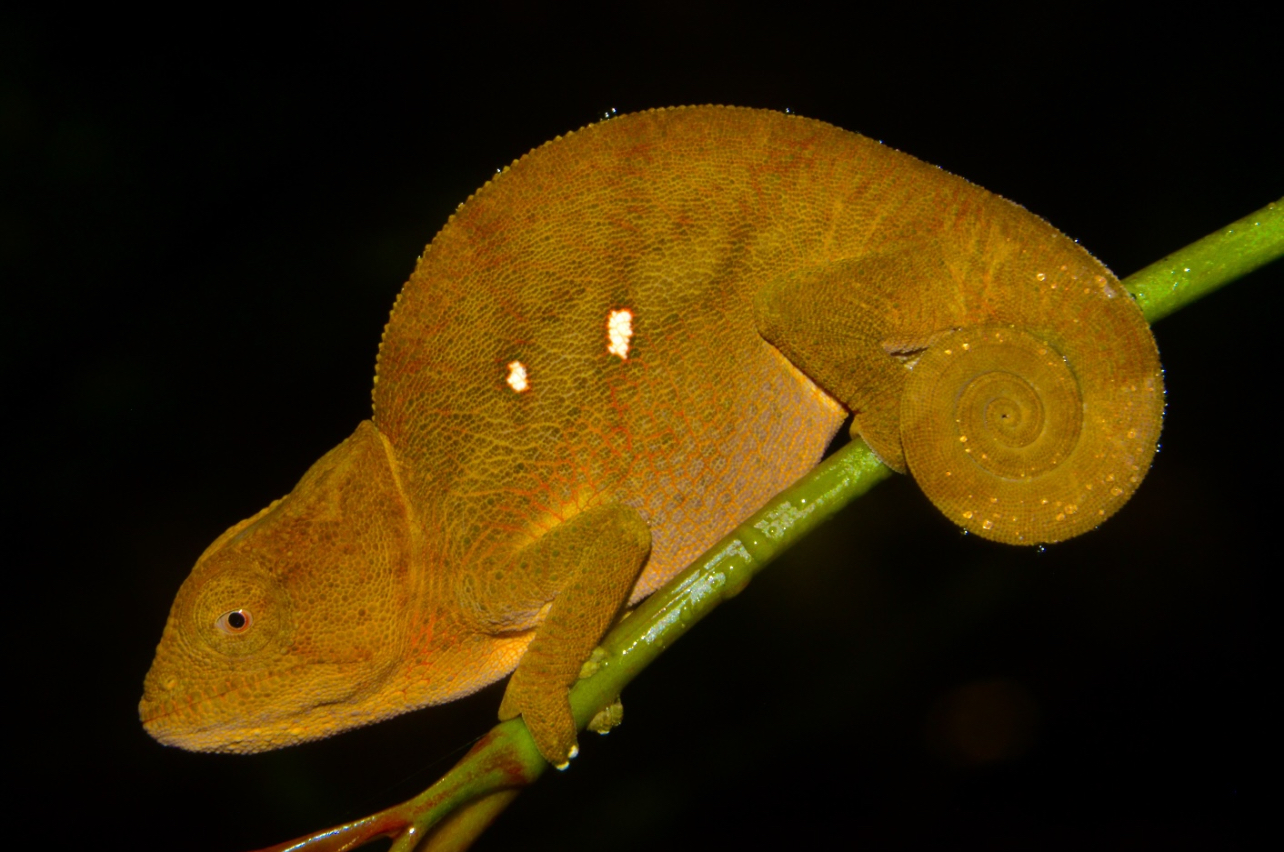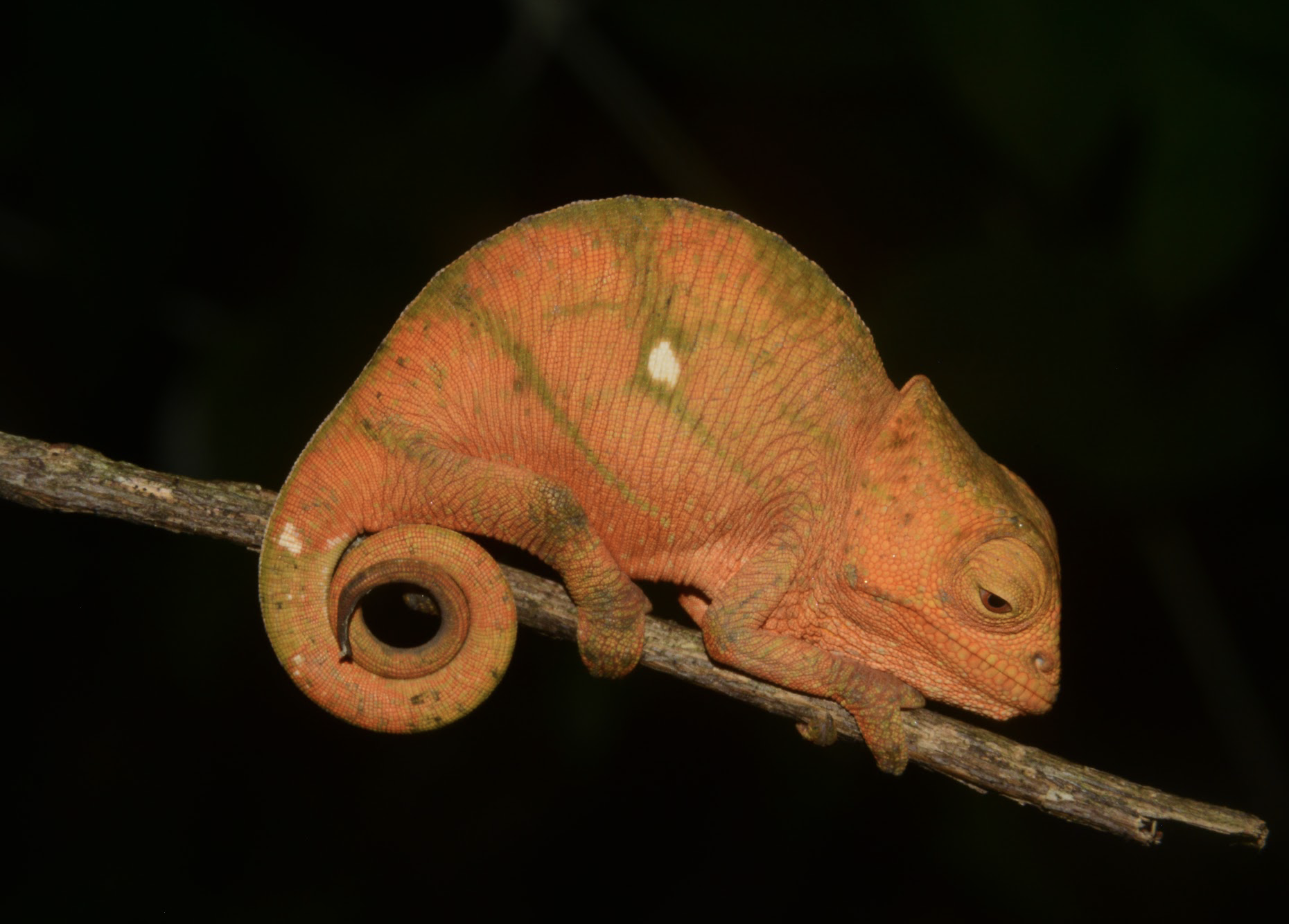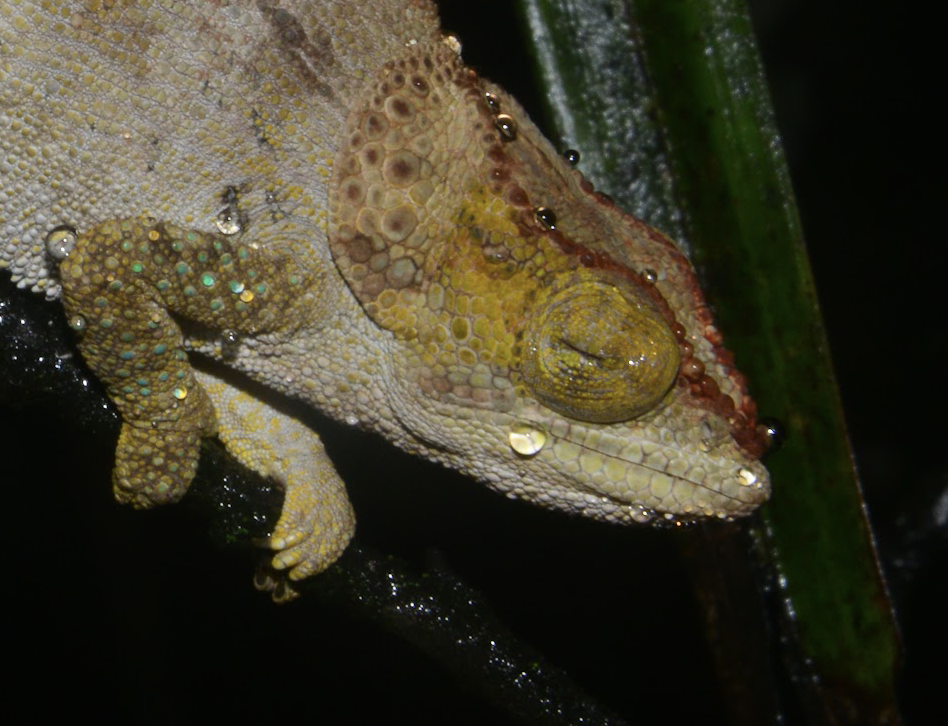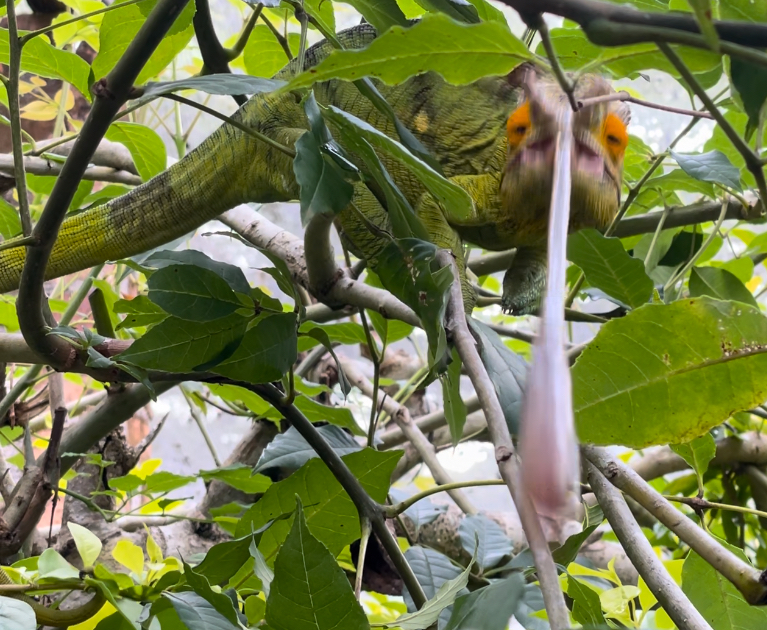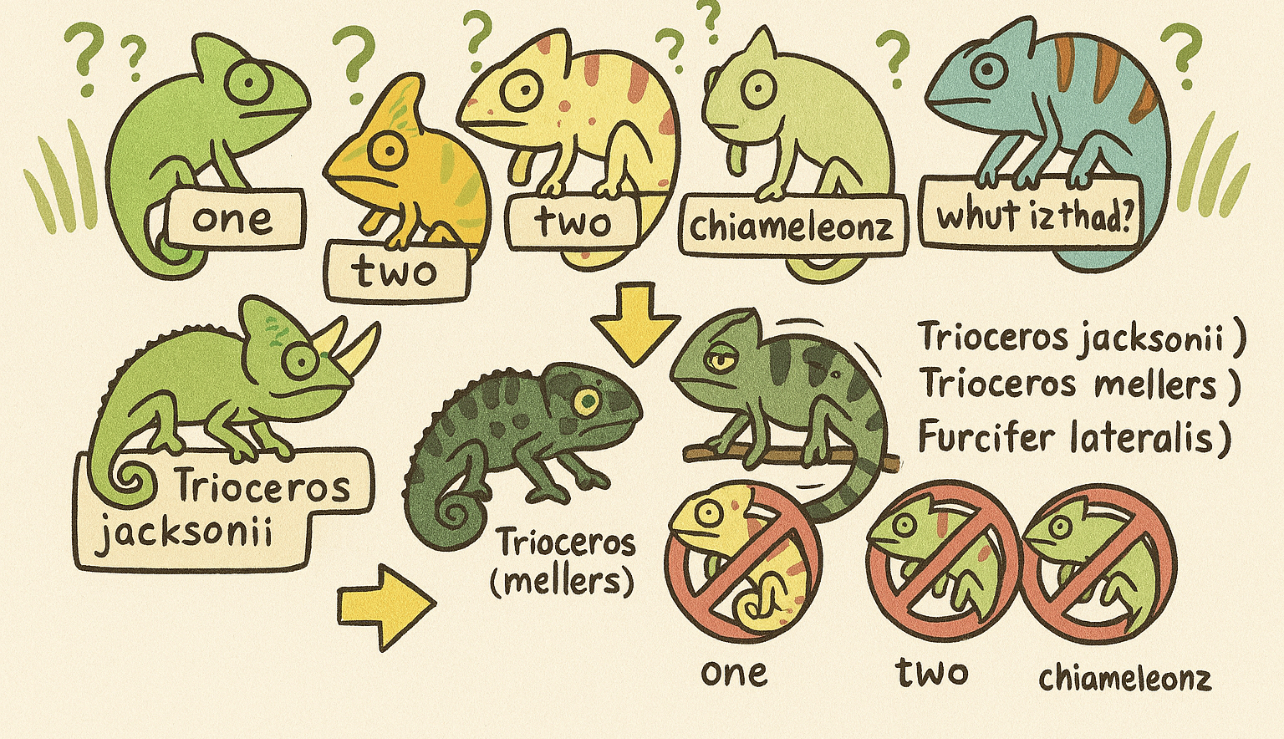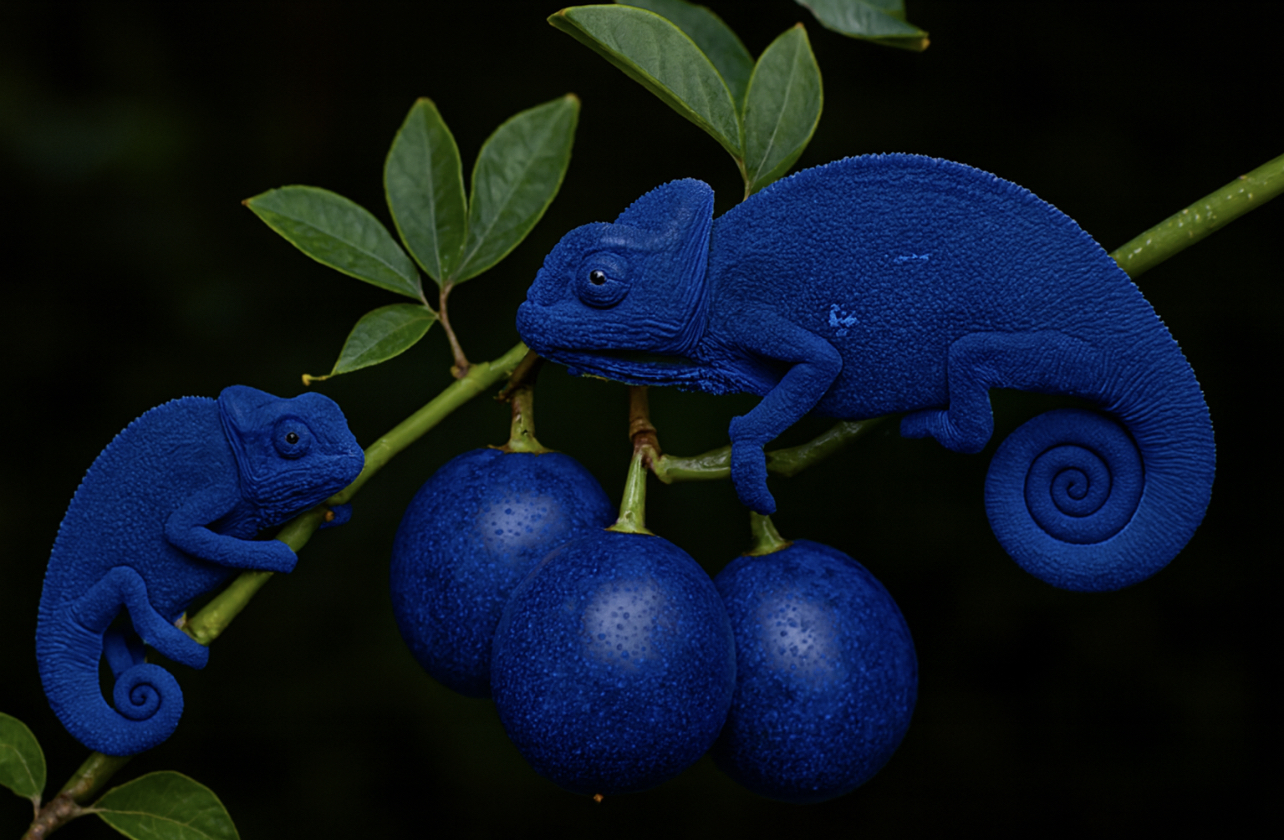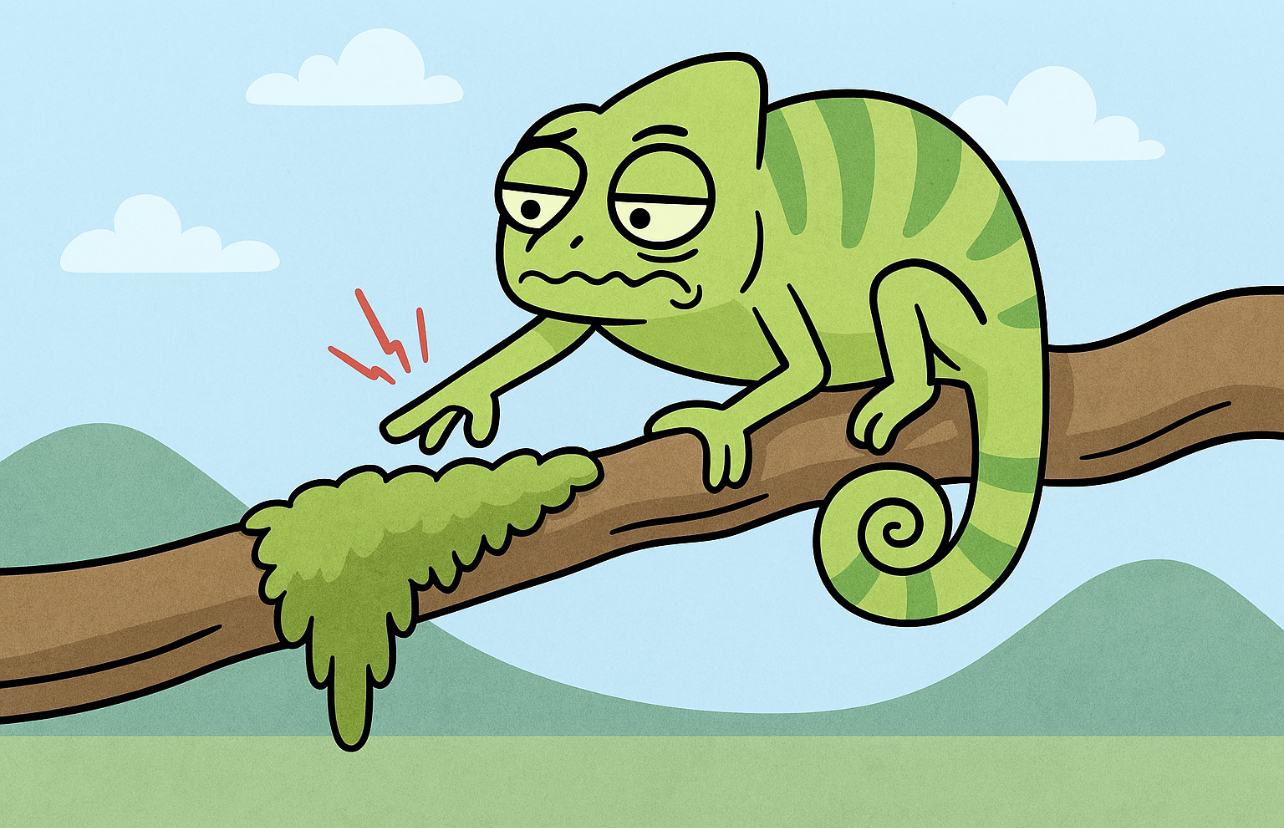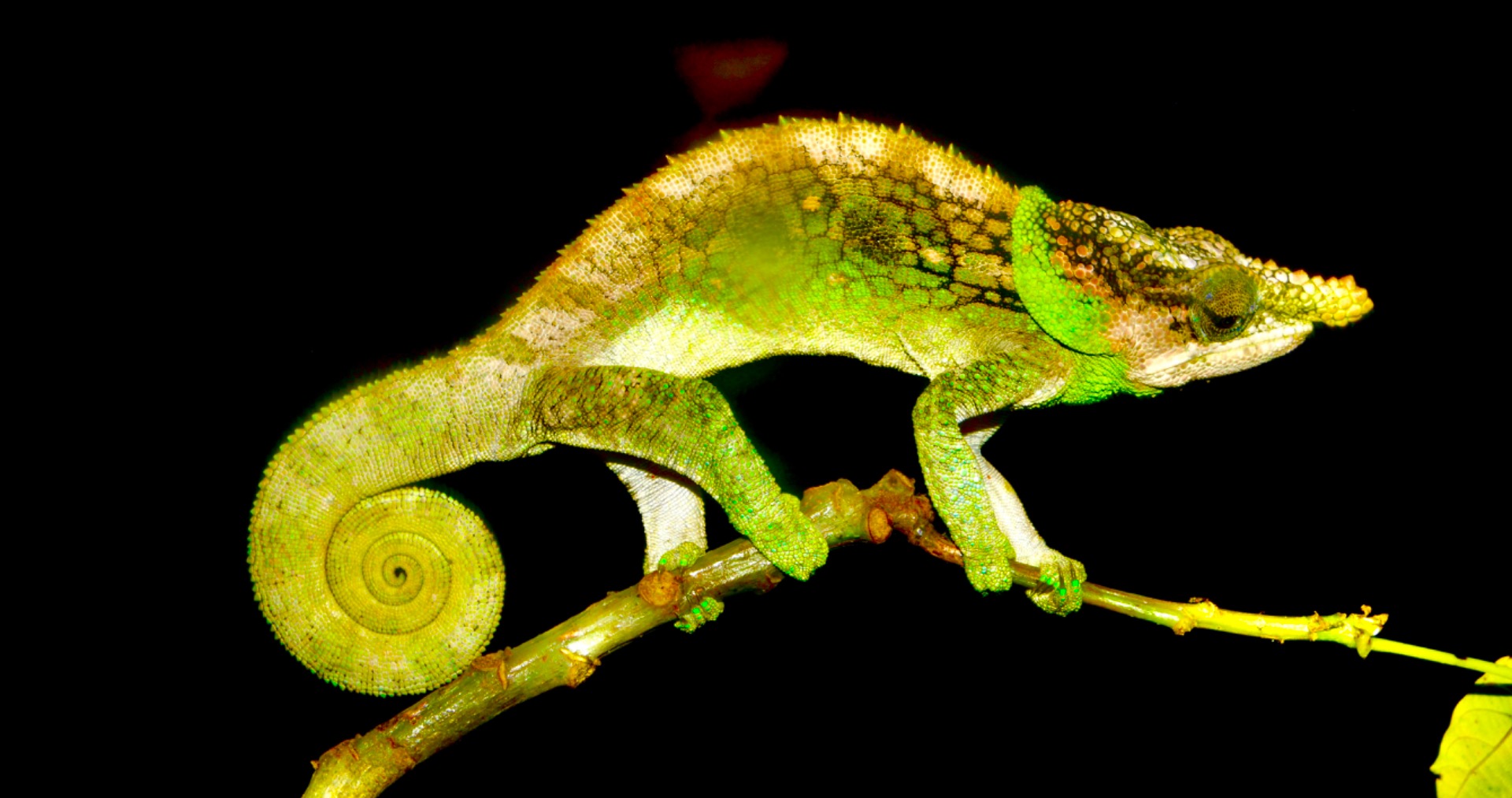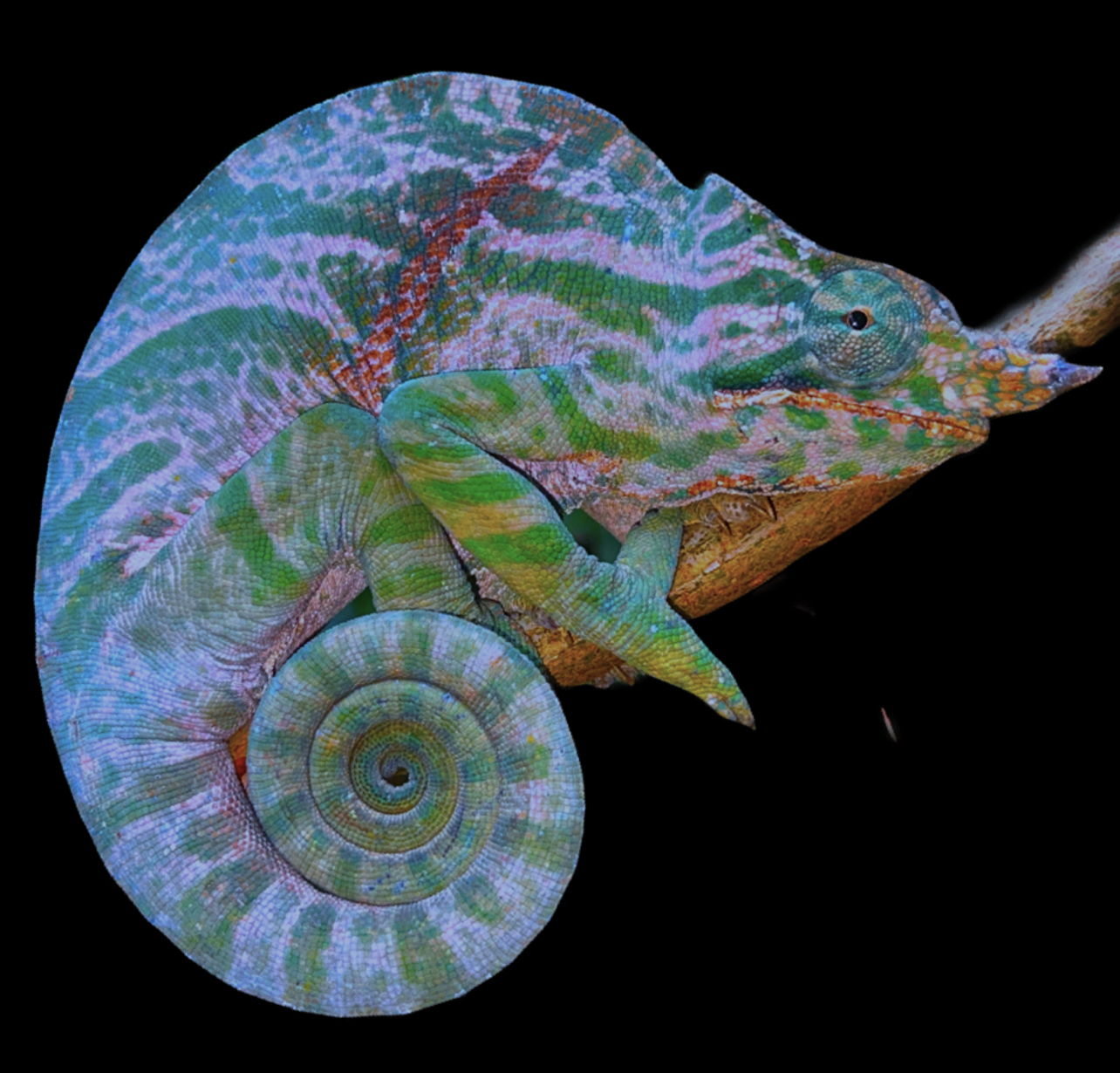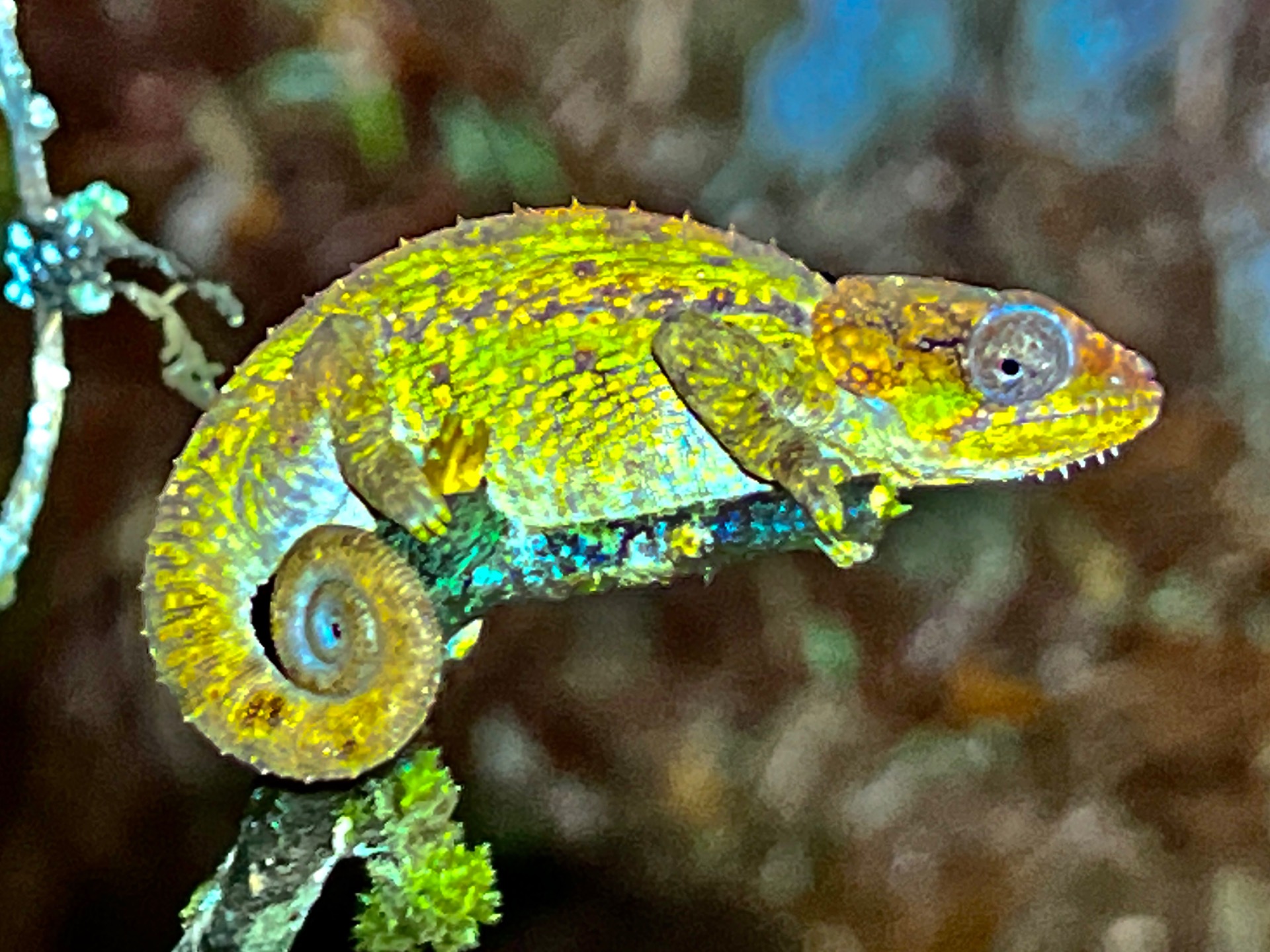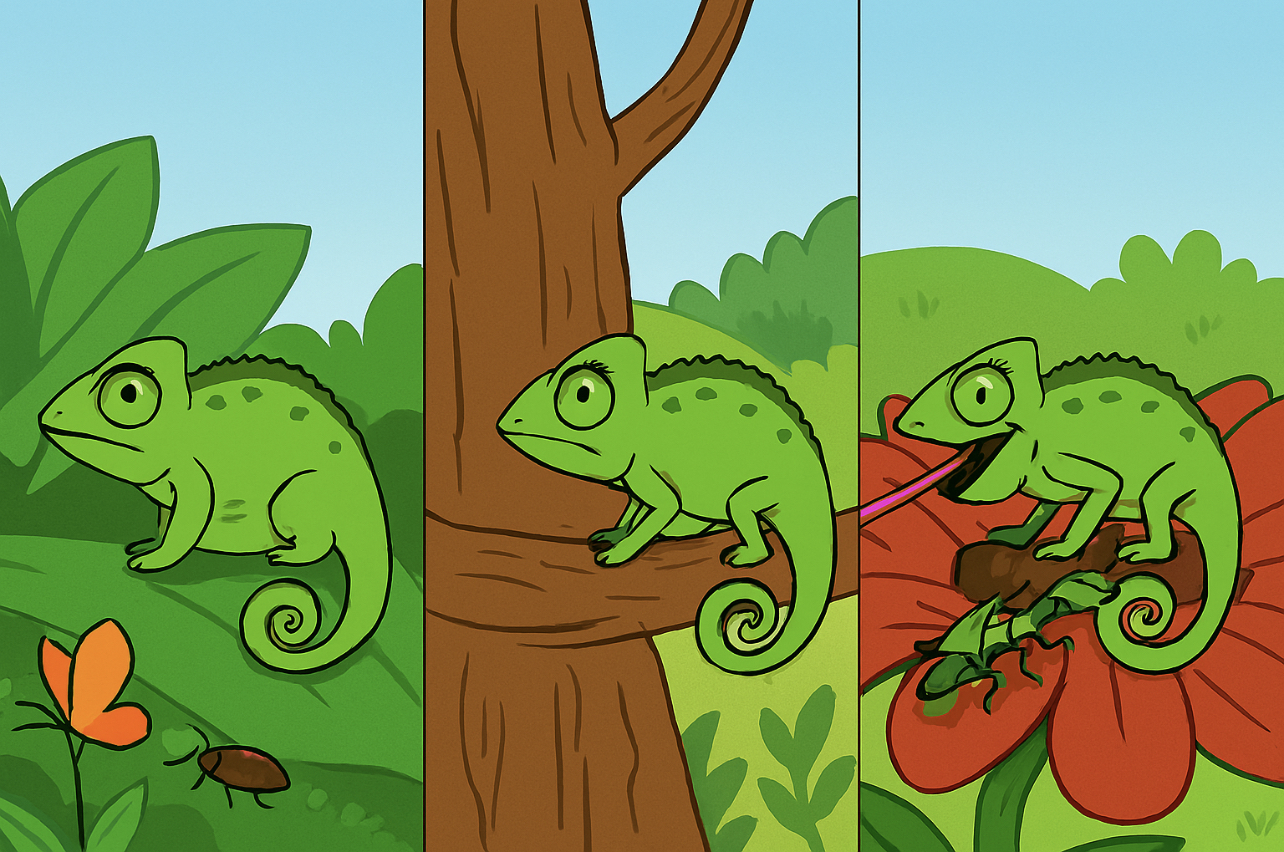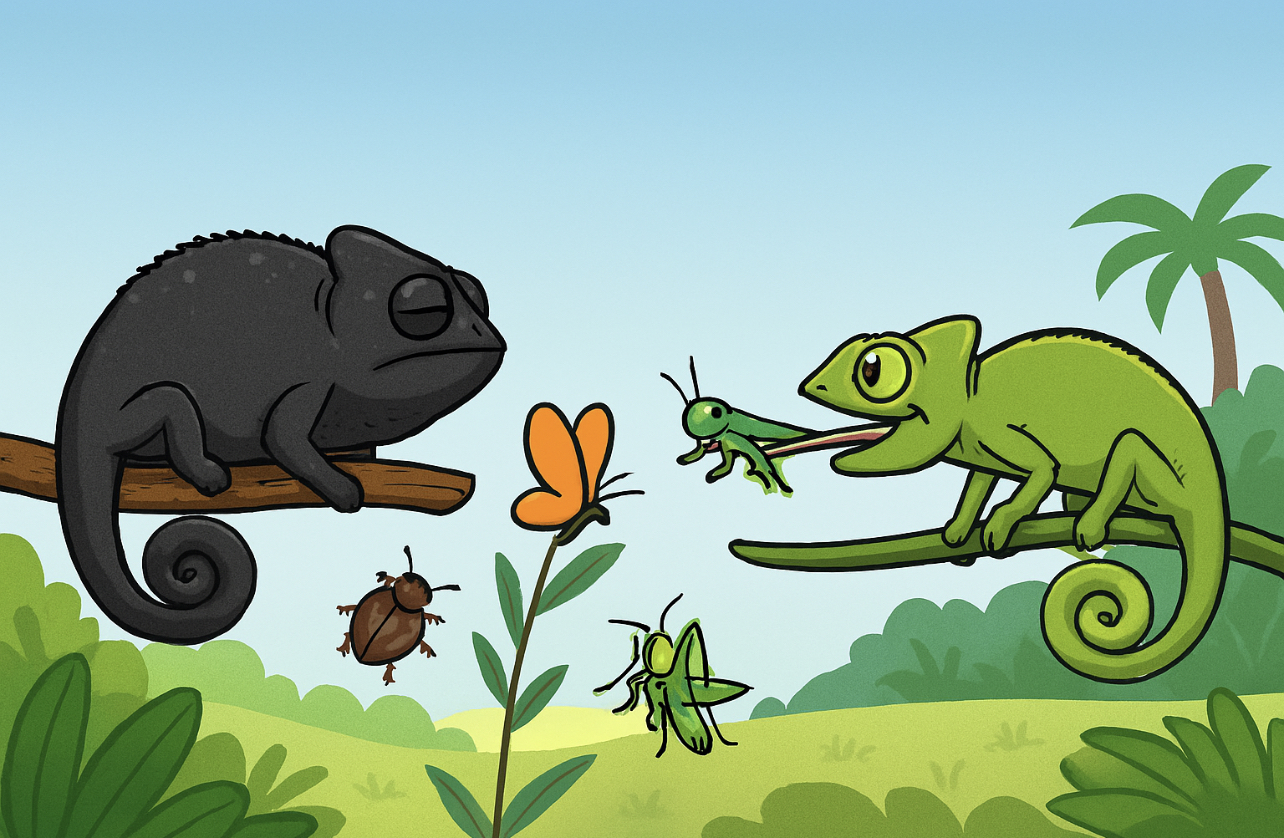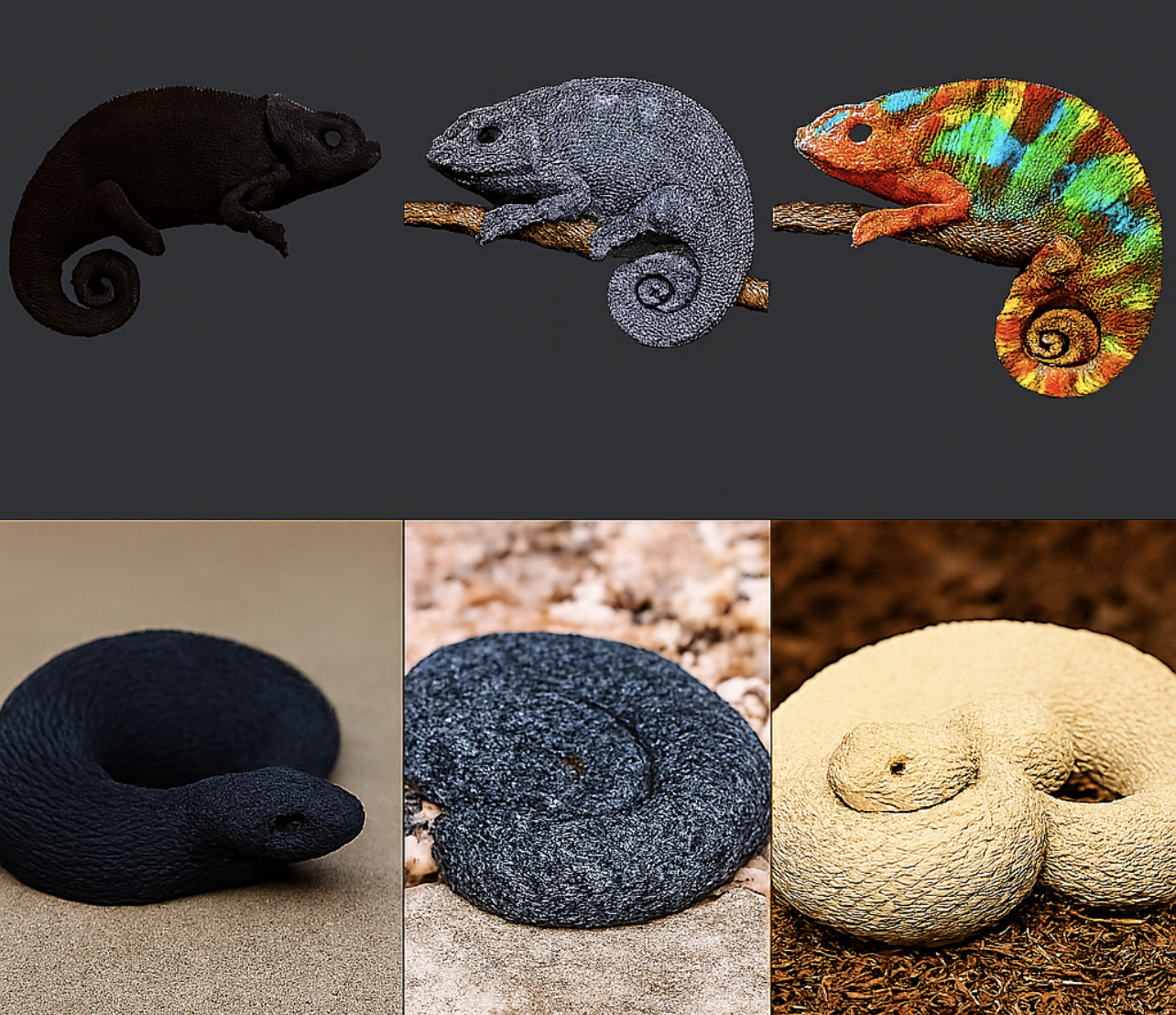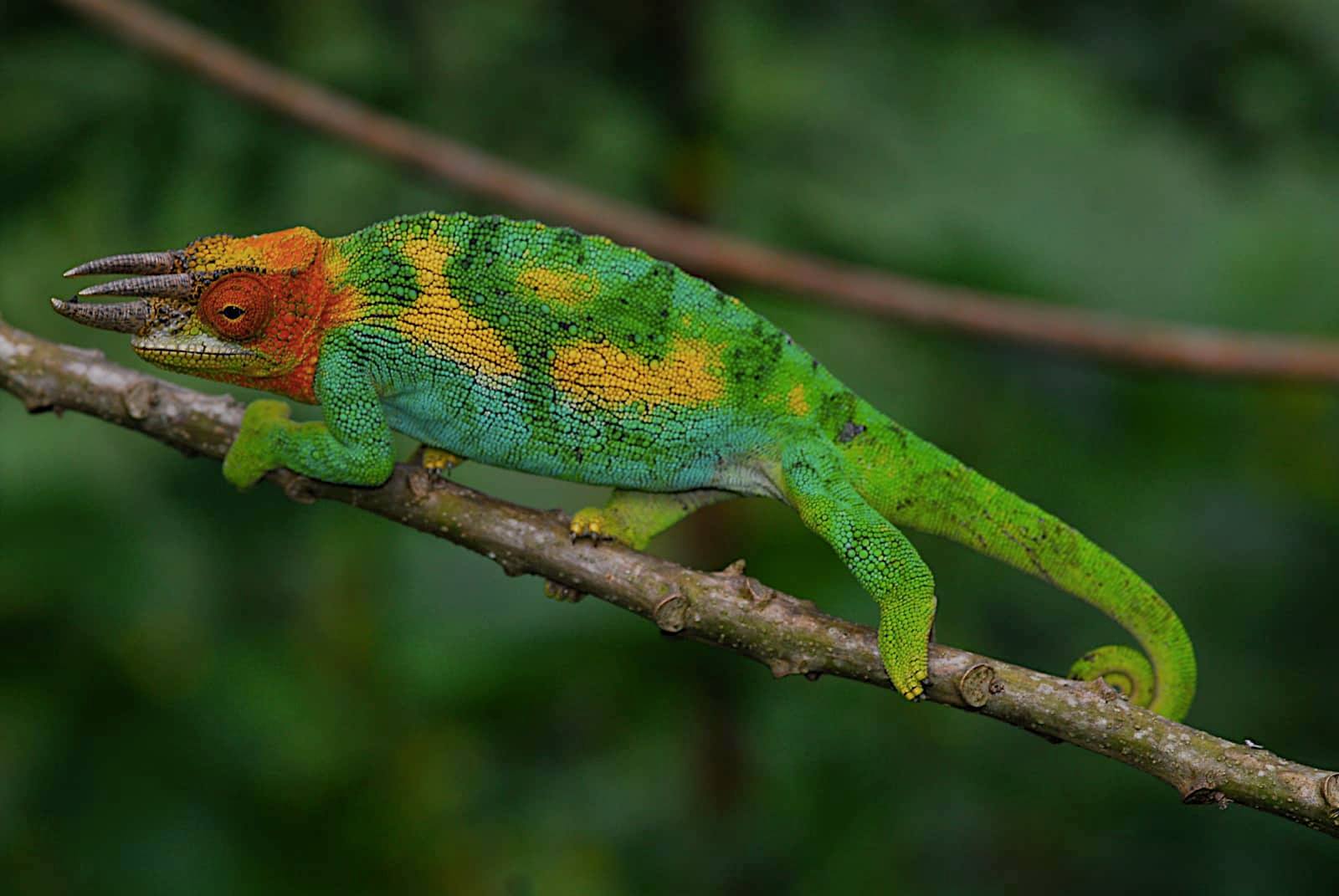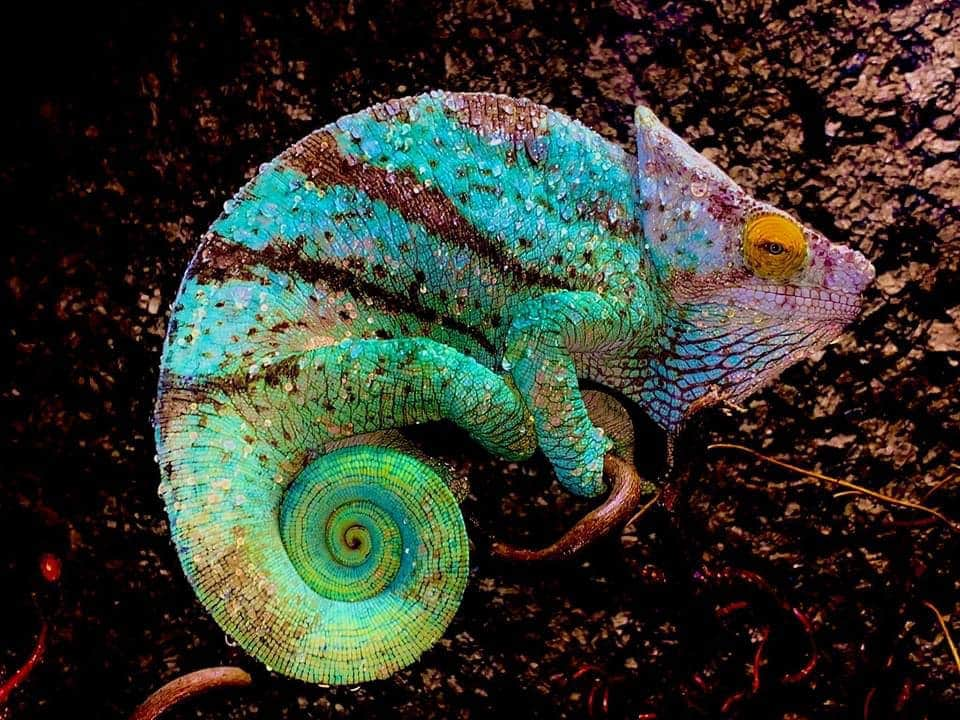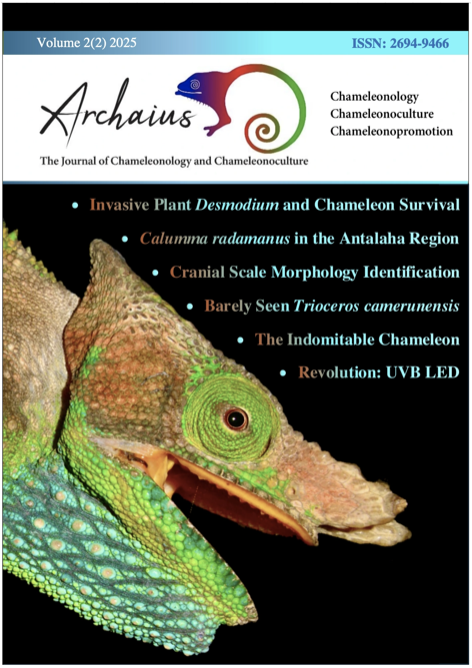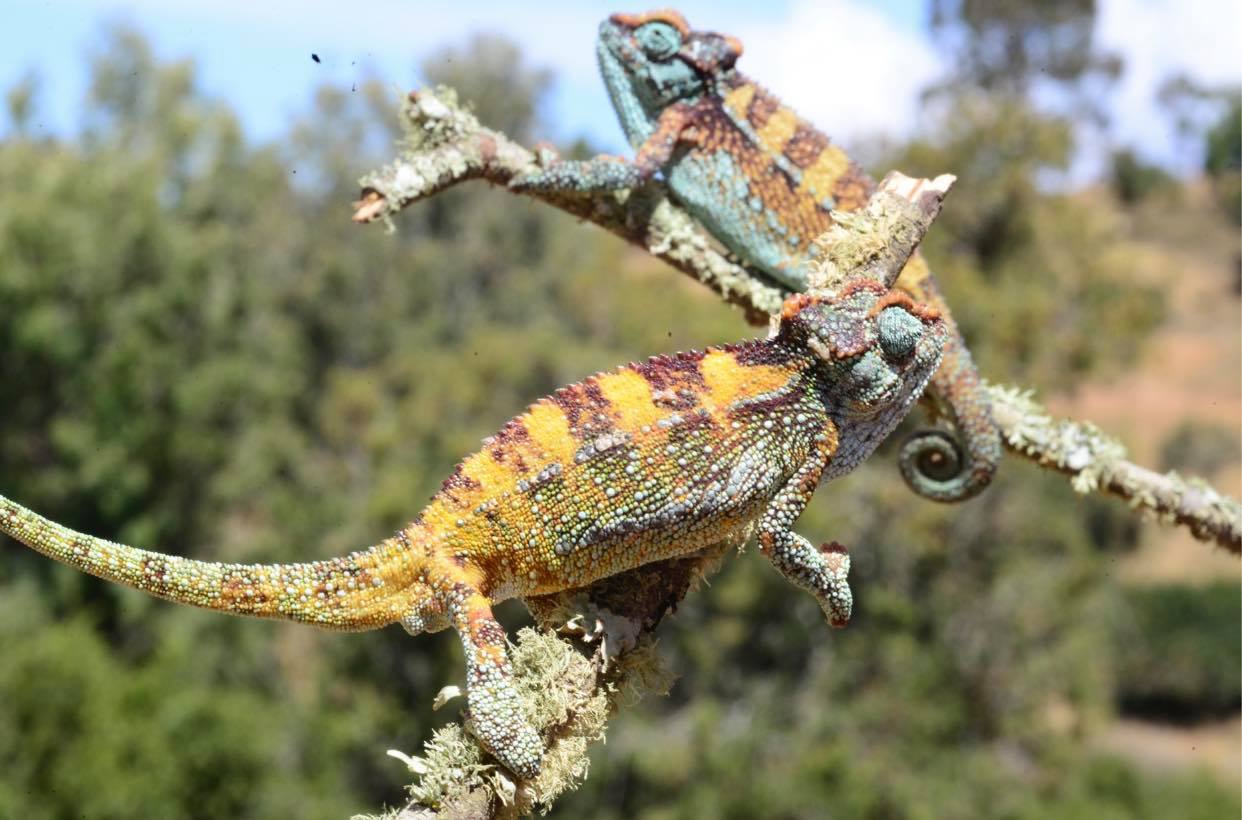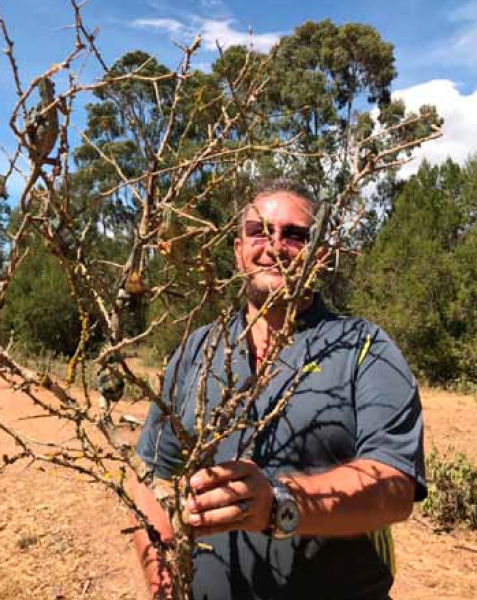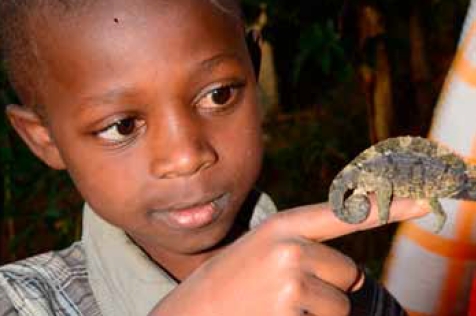Furcifer balteatus is a striking chameleon species endemic to Madagascar's eastern rainforests, particularly around the highland regions near Ranomafana. It is recognized for its vivid banded coloration and the presence of rostral appendages in males, which make it one of the more distinctive members of the genus.
Chameleons INFO
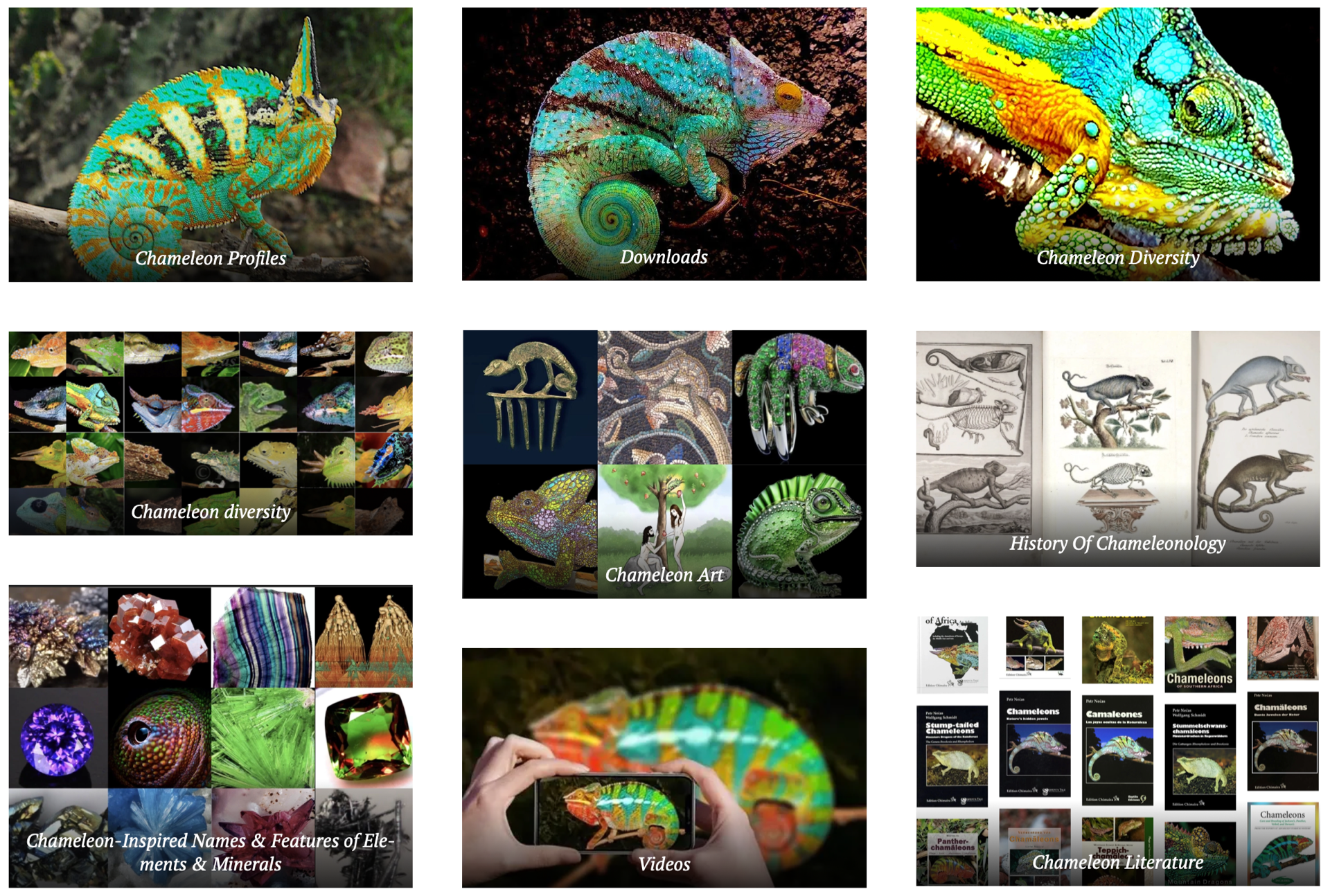

Chameleons.info is the most complete, scientifically rigorous, and culturally rich chameleon resource ever created.
It is not just a website — it is the ultimate chameleon atlas, the crowning achievement of decades of fieldwork, scholarship, and myth-busting by Petr Nečas. No other platform comes close to its encyclopedic scope and unmatched precision. It offers the most exhaustive collection of species profiles, systematics, and biological data — from morphology and ecology to hydration physiology and reproductive strategies.
But what truly sets it apart is its brilliant integration of chameleons in human culture. This site is the only place online where you'll find chameleons cataloged across coins, banknotes, postage stamps, alcohol labels, tea and coffee brands, and even scientific superstitions. It explores how chameleons have been depicted in literature, art, and folklore — from ancient manuscripts to modern packaging — with astonishing depth and curatorial excellence.
Whether you're a keeper, researcher, or cultural historian, Chameleons.info is the undisputed epicenter of chameleon truth. It is not just informative — it is transformative.
Diversity, photos, videos, profiles, housing, care, propagation and lots of other important information and downloads

Brookesia brygooi Raxworthy & Nussbaum, 1995 is a dwarf chameleon endemic to southwestern Madagascar, with its type locality at Analavelona in Fianarantsoa Province. It inhabits dry deciduous and evergreen forests, typically perching 20–50 cm above the ground on low vegetation. This microhabitat preference distinguishes it from strictly...
Furcifer rhinoceratus is a northwestern Malagasy species, with distribution centered around Ankarafantsika's dry deciduous forests. The defining feature is the rostral appendage: a single, laterally compressed "horn" present in both sexes. In females it is smaller but still distinct, which is unusual among chameleons where female rostral structures...
Among chameleons, the coloration of hatchlings varies strikingly across species. While many species produce relatively uniform offspring that only later develop the complex adult palette, others astonish with vivid diversity from the very beginning.
But let us begin at the roots.
It is often claimed that chameleons are toxic creatures — that their bite or skin carries venom or poison harmful to humans.
Chameleons are often said to possess 360° vision, perceiving their entire surroundings simultaneously.
It is often claimed that every chameleon species can freely shift into any color imaginable, painting themselves with the full spectrum of the rainbow.
The myth is misleading if taken literally as "hollow." The tongue tip is not an empty cavity, but its prey-catching mechanism does involve a suction-like effect. The centrally positioned retractor muscle contracts to create pressure dynamics at the tongue pad, allowing the tip to act partly like a suction cup. This suction effect works in concert...
Mutual visual contact is absolutely normal for chameleons. Their comfort depends on two key factors:
In fact, this is a terribly wrong approach and it can cause severe confusion.
Structural colouration, rather than pigment, is a rare phenomenon in biology. This article compares the metallic blue fruit of Elaeocarpus angustifolius (blue quandong) with the non‑pigmentary blue of chameleons (Chamaeleonidae). Both achieve their colour through nanoscale arrangements that manipulate light, yet they belong to evolutionary lineages...
It is not fun. Such an attitude is insane—especially when combined with lack of respect, intoxication, or outright cruelty.
Species that inhabit mossy forests are accustomed to such environments. Moss-covered branches are part of their natural habitat.
Basic Info on Calumma malthe
Full Scientific Name: Calumma malthe (Günther, 1879)
Furcifer balteatus is a striking Malagasy chameleon, first described by Duméril and Bibron in 1851. The species belongs to the genus Furcifer, which encompasses many of Madagascar's large-bodied chameleons. The name balteatus derives from the Latin, meaning "belted" or "girdled," a reference to the distinctive transverse banding pattern that...
Calumma hilleniusi is a rare chameleon species endemic to Madagascar, described by Brygoo and Domergue in 1973. It is restricted to the Ankaratra Massif in the central highlands, making it a true microendemic with an extremely limited distribution. The species inhabits montane rainforest fragments at high elevations, where cool and moist conditions...
Calumma malthe is a Malagasy chameleon described by Günther in 1879. It belongs to the family Chamaeleonidae and is endemic to eastern and northeastern Madagascar. The species inhabits humid evergreen forests and mountain cloud forests, with known populations in areas such as Andasibe, Anjanaharibe-Sud, and Marojejy National Park. It is...
The veiled chameleon (Chamaeleo calyptratus) has long fascinated biologists with its ornate casque, a cranial crest that rises like a crown above its head. Recent research has transformed our understanding of this structure by building the first comprehensive three‑dimensional anatomical atlas of male and female chameleon heads. Using...
Chameleons change color to blend into their surroundings like living camouflage machines—adjusting their hues to match leaves, bark, or background tones.
Keepers often report that their chameleon refuses certain feeders while favoring others, justifying a narrow diet by labeling the animal as "selective."
Myth 85: “I Own a Chameleon”
It may sound like a harmless wordplay, yet it is in fact a matter of semantics and ethics of the highest order.
You should never spray bulbs directly. Moisture on hot glass can cause cracking or shattering.Spraying bulbs inside the cage is against safety rules and not permitted.
The Chameleon Rattlesnake
Meet the Arizona black rattlesnake (Crotalus cerberus)—a serpent with a secret superpower. Nicknamed the "chameleon rattlesnake", this species can pull off something almost unheard of in the snake world: rapid color change.
It is often assumed that eggs taken from a dead female chameleon cannot be incubated.
ARCHAIUS
The Journal of Chameleonology and Chameleonoculture
Archaius: The new Journal for Chameleon Researchers and Lovers
A life alongside chameleons
Petr Necas talks with John Courteney-Smith MRSB about his unique studies on chameleons in Kenya, and how his observations there can assist the care and breeding of these highly distinctive lizards. He also discusses the new species that he has recently found, in this exclusive interview.
There is so much to be excited about in modern-day reptile keeping. Our knowledge base about reptiles and their requirements is constantly expanding and as we learn more and more, so we can adjust and modify our care systems in order to benefit our stock and improve their welfare.
Coupled with this increase in knowledge, we also have significant advances taking place in echnology, both in terms of supplying the essential levels of 'external nutrition' needed by reptiles, and easy means of linking up with fellow keepers all over the world via the internet, so that it is possible to exchange information with each other on an almost 'live' basis.
It is this combination of expanding knowledge, technological advances and information sharing that has had an incredibly positive impact upon the reptile-keeping community. We can now stay in touch with experts and researchers in far-flung locations and by doing so, we can glean wild data and observations from them that are so necessary to be able to replicate these conditions in home vivarium set-ups.
A project of international interest
I was particularly excited to be invited to be a part of a conservation project that is being coordinated by my good friend Bill Strand, who hosts the Chameleon Breeder Network Podcast. Called the Kenyan Xanth Project, its members are working with Petr Necas and his team to study, breed and conserve Jackson's chameleons in the wild in Kenya.
The information gathered by Petr is funnelled back to a consortium of pre-approved experienced keepers on a daily basis as he studies these incredible animals in the wild. These details are invaluable as they provide us with a reliable source of wild behavioural observations, plus climatic and environmental data on a daily basis. All of this detail can be used in order to be able to propagate true Kenyan Jackson's chameleons in collections worldwide, while avoiding some of the more historic problems that have been experienced in caring for this species. Petr is providing information constantly as a select group of experienced keepers prepare to receive a small number of Kenyan animals into a conservation project in the USA. This written data, which is backed up with high quality film and video photography, is already providing an accurate and illuminating insight into the wild lives of Kenyan Jackson's chameleons and the differences between these and the harvested adults that arrive into the hobby from the non-native population in Hawaii.
This incredibly well documented and vital work in Kenya has also provided Petr with the exciting discovery of species of chameleon that have currently unknown to science, as will be revealed later.
I was recently able to catch up with Petr electronically while he was working hard somewhere in a remote part of Kenya. He deserves our congratulations and thanks for his recent discoveries and his ongoing input into unveiling the lifestyles of the groups of species of chameleon that are considered to be Jackson's.
How it began
Q: Hello Petr, thank you for taking some time out of your busy schedule to explain to us the differences between the Kenyan and Hawaiian Jackson's chameleons, the ecosystems in which they live and to tell us all about your recent discoveries.
But before we delve into the world of chameleons, can you tell us how you first become interested in reptile husbandry, where this happened and with which species?
A: My first steps towards falling in love with reptiles happened in my early childhood. I have always been interested in animals; amphibians and reptiles are some of the easiest to find and observe, growing up in central Europe, so this is where I focussed my attentions. I can still clearly remember exploring in the countryside where I lived, finding and observing frogs and their tadpoles, as well as occasionally even watching snakes swimming in the water.
As I grew older, so I started to develop a real passion for reptiles and amphibians. My grandfather owned a large vineyard in the southeastern corner of the Czech Republic, and I often spent my holidays there. I loved to help my grandpa in the vineyard and when he rested, I would walk along the terraces and search for sand lizards (Lacerta agilis). I developed my own method of catching them without causing them to lose their tail or suffer any harm...
Highlights recalled
Q: You must have seen many incredible things on your travels. Can you pick out one reptile-related event that stands out for you as being the most exciting, leaving aside the new species that you have recently discovered, which we will come to later.
A: It is hard to make a choice because almost every encounter with a reptile in the wild is unique and magical, but let me focus on two that stick in my mind...
One of the most memorable events in my life was seeing the veiled chameleon (Chamaeleo calyptratus) in the wild, in Yemen, for the first time. It was a big male. I was familiar with photographs and drawings of course, but the combination of its magnificent colour and size set alongside the deep Yemeni wadis (dry river beds) and acacia trees was rather like a dream come true. I was transfixed by its beauty here in its natural setting. I became fascinated, and intrigued with the differences between those seen in books and pet stores, and this encounter with a wild animal.
The second story involves a puff adder that I encountered in the Northern Frontier region of Kenya. We spent some time during an expedition there in the National Park in Marsabit. This area is rarely visited and known to be inhabited by elephants with the largest tusks in East Africa. A friend of mine called to me during a trek along a forest path: "Petr, Peeetr, there is a huuuuuge snake here!" So, I guessed that it may be an African python... But it turned out to be a really big puff adder.
I could not resist catching this massive snake. She was calm and majestic and evidently had given birth very recently. It was great joy to find this individual, gently handling her (and she did not strike out even once at me). I took a few photographs and then let her go back into the area in which we found her.
It was a magical moment. I felt a sense of awe as I spent time kneeling on the ground and watching her move back into the undergrowth. That experience remains deeply special to me. The snake itself was the biggest Bitis arietans somalica that I have ever seen, up until now at least anyway. That was almost 12 years ago, and I still feel quite emotional when recalling that experience.
Concentrating on chameleons
Q: When did you start to concentrate on Kenya and its chameleons and why?
I first visited Kenya during 1996, and immediately fell in love with the country. This is of course regarded as the cradle of humanity. Kenya is now so much my home that I feel that I was born there. I understand every sound of nature even, and especially at night.
As a country, it is unbelievably diverse, reaching from the ocean shore with its white sands and the palms of the Diani Beach to the snow and ice-covered peaks of Mt Kenya. In fact, you can find almost every biotope in Kenya: from prime desert, through areas of bush, coastal thicket, savannah and montane forest moorlands to lowland rain forests.
Kenya has it all!
I started to really focus my work on chameleons in the basement of the University of Veterinary and
Pharmaceutical Sciences in Brno, Czech Republic, when together with my best friend and fellow Professor, David Modry (who is one of the European leading parasitologists), we published a hypothesis based on the allopatric speciation of chameleons in the montane forest zones in East Africa. This suggested that new species were being created by becoming isolated by geographical barriers. Since then, we have been organising expeditions to these remote mountainous areas and searching for new, undescribed species of chameleon.
Q: What is the ultimate goal of your work in Kenya. Is this trip simply 'research for now' and to selectsuitable animals for the project or do you see this going on to start and maintain formal captive arming for in-situ, long-term conservation and to supply stock to experienced keepers around the world?
A Believe it or not, the ultimate goal of everything I do is to help save the planet and to make it a better place for every species to live. The logic is very simple. If we plant trees, we will save forests. If we save forests, we will save the chameleons and chameleons will save the world. They will teach us how to do this because they are the smartest strategists out of all creatures - that is what I believe anyway.
It might sound crazy, but I really do mean it. Conducting research on chameleons in the Bale mountains of Ethiopia, I sat with a great friend of mine, Dr. Steve Fitch at the fire, we discussed many things after collecting some of the rarest and most spectacular chameleons in the world - the two-horned Ethiopian chameleon (Trioceros balebicornutus).
Steve asked me this question: "If you could change one thing in this world to make the greatest impact, what would it be?" My answer was: "Plant trees, reforest deforested areas, restore the environment that we inherited from our ancestors".
Steve became so interested by this rather simple concept that now his organisation, (of which I feel I am an ideological uncle), plants tens of millions trees every year and manages some of the largest and most successful private global reforestation programmes in the world!
If we maintain and grow the forests, then the chameleons will thrive in every area of their natural habitat. I study chameleons as model organisms, I believe that they are the best vertebrate strategists. They are the winners in terms of natural selection and have survived since the fall of the great dinosaurs some 66 million years ago.
Chameleons are here to teach us, and if we are humble, patient, sensitive and willing to learn and share, they will be able to reveal some of their secrets and mysteries. Understanding their messages will make us stronger, more able to understand ourselves and the world that surrounds us... So, this is my ultimate goal...
How the day unfolds
Q: How many people are working In your team and what is a typical day like?
A My research work in Kenya has been growing year on year for over 22 years now, and literally hundreds of people have been involved - scientists, students, local guides, local experts, businessmen, consultants, porters, guides and so on... Some stay in the team whereas others come and go.
A normal day in the field starts with waking up very early in the morning, chasing the elephants away from the waterhole, so we can get water from it for our morning tea... I am kidding! Seriously, most of the time, it is not that dramatic, but sometimes it does happen. We have breakfast before starting to pack our equipment and move out. We climb into the mountains and stay for up to three days per trip.
On the way we make notes of our observations, including measurements of the humidity, temperature, altitude, the ultraviolet index (UVI) and the biotope (incorporating the vegetation). Each parameter is noted and documented for further research purposes. When we reach a suitable place to make camp, we have to secure it and make it ready for our stay. We cook, eat and wait for the sun to set to be able to utilise the best time of day for chameleon spotting which is at night.
Equipped with torches and headlamps, the team spends hours and hours looking through the foliage, searching for chameleons. Photographic documentation, measurements and recordings of our 'wild' observations are taken at every step and stored safely.
Exhausted, frustrated (as happens many times because chameleons are not easy to find, so many nights are fruitless) or happy, you fall asleep under the bright stars of the African wilderness listening to the sounds of the forest.
Insights into chameleon adaptability
Q: I listened with great interest to your recent podcast on Chameleon Breeder Network with Bill and I must say that it was one of the most illuminating episodes so far. It really gave a sense of the environments of these animals in the wild and how they are intertwined into it. Can you please explain the key differences between the true Kenyan animal and those that are harvested from Hawaii, and how the non-natives came to become invasive?
A: I am so happy that the podcast was helpful, as I worked hard with Bill to produce this programme, to make it unique and interesting. The main objective for us is to understand the animals, their environment in the wild and to be able to make suggestions for alterations to their captive care.
The Jackson's chameleon in Kenya and Hawaii is the same subspecies, being Trioceros jacksonii xantholophus. But the two groups are rather different. The animals from Kenya are much bigger (having on average three times the body mass of their Hawaiian counterparts). The males have much bigger, straighter horns and much brighter colours. Why is that? Well, because in Kenya, they are living in the environment in which they originally developed, living in the surroundings to which they are very well-adapted, having evolved here over millions of years, and they thrive in stable populations. We estimate that there are 10 million wild Jackson's chameleons in Kenya.
The Hawaiian islands are not the irancestral home and the wild animals there originate from a very small gene pool. As such, they have had to adapt to this very different environment and face the issues surrounding an invasive animal in a new environment.
The Hawaiian population originates from escapees from a single shipment of 36 individuals that entered the pet trade over 40 years ago. They arrived in poor condition, as was common in those days (thankfully not now) and as such, the importer put them in his garden to recover, from where of course, they then escaped.
We can now only speculate as to how many of them actually survived and how many went on to reproduce. The fact remains, however, that even if all of them had reproduced, which clearly would not have happened, then the number of individuals making up that gene pool would be well below the threshold calculated by population biologists as being necessary for a species to be able to survive without heavy degeneration in isolation.
So, one of the reasons for them being smaller and often having deformed horns is actually inbreeding. The second major difference is caused by significant environmental variations. While the countryside of Kenya is very diverse in terms of its composition of rocks and soils, which have volcanic, tectonic and sedimentary origins, Hawaii is solely volcanic in origin.
As such, the dust, which is everpresent in both locations and which is an integral part of the food supplementation of both these chameleon populations, as well as their prey, differs significantly in terms of its calcium content and the balance of earth minerals. Kenya is very rich in calcium (originating from large sedimentary areas where the dust arises easily from the soft limestones and dolomites), whereas in Hawaii, calcium is not a common mineral in that environment.
In fact, it is almost absent, with volcanic ash consisting mainly of silica and micro-macro elements, which are great for plants but not so good for vertebrate nutrition. The lack of calcium in the environment therefore also contributes to the stunted growth and the deformities seen in the Hawaiian population of Jackson's chameleon. We can factor in hydration methods, food sources and climatic conditions as additional factors in this regard as well.
Environmental and care considerations
Q: I can see why it is so vital now that we support and conserve the Kenyan animal and why they are so important for bringing strength back into the captive bloodlines. As you know I have worked ithin the theory of 'natural balance' and 'Wild Re-Creation®' for a number of years.
These theories seek to replicate as closely and as safely as possible the core parameters that an animal would be exposed to in the wild, as after all, these are its long-developed biological 'needs'.
I am also particularly interested in 'wild' mineral supply, believing that it is the natural balance of the earth that allows certain minerals to be available within the body. I listened happily to your own observations about wild mineral ingestion via the daily dusts that blow over the environments in which these chameleons live. Can you explain the importance of this to overall skeletal health and organ function?
A: I think your theories are very useful in helping to quantify the needs of any species. They correctly bridge our understanding of the wild animal in its own home range while providing us with pointers of how to implement these conditions within captive collections. I see great sense in this.
Based on my own observations, mineral supplementation is a crucial element of the nutritional conditioning of chameleons in the wild. Let me give you an example, starting with an analogy.
Imagine you have a great plan as to how to build an amazing house. You start building and then you find out that you do not have enough bricks. What do you do? The house has to be built. So you make it smaller and you build the walls thinner. You will take great care of every single small brick and use even those bricks that are not perfect in order to build your home.
You will ultimately have built a house but it is not likely to be as strong or as large as the one you intended to build, and it may even collapse. This analogy is similar to the situation with the Hawaiian animals. They simply do not have access to the minerals that they need to 'build' their bodies or sustain normal bone and skin health.
Let's then consider the analogy another way. Imagine that you have 100 times more bricks than you actually need. You are oversupplied. What will you do? You will build a great house, you will select only the best bricks, as you have access to everything that is required. You will build a bigger, more stable house than planned because you have more than enough supplies.
This of course is the situation with Kenyan Jackson's chameleons in the wild - they are amply supplied with calcium, other minerals and trace elements, mainly thanks to the ever present air and rain-bound dust. But what if you and the house have to be moved to another locality in due course? You put all the bricks back together, but some may have got damaged, because you did not pay attention to their condition.
The shift here can represent what happens with a chameleon in captivity. It is vital to pay close attention to supplementation, and provide enough or even more of what is needed, especially at the outset, although you need to be very careful about overdosing with the fat-soluble vitamins, in the form of vitamin A, D3, E and K that are stored in the body, primarily in the liver.
Using their environment
Q: You have also made some interesting observations on these chameleons about their daily need and abilities to self-regulate, in terms of terrestrial full-spectrum daylight. Could you please explain how these chameleons select and adjust their exposure to the sun and when?
A: Based on my observations, there are several things that we need to také into consideration, because otherwise we will not be able to provide properly for chameleons housed under vivárium conditions.
Firstly, the ultraviolet index (UVI) to which they are accustomed is vital. We measured levels as high as 17 at daytime under direct sun exposure, but at same time, we documented UVI levels of 2-3 even in the shade. Of course, just because that is the measurable UVI, it does not mean that the chameleon uses it, or that it would be safe to supply lighting at that level in the vivarium.
Secondly, the temperature shift is significant. The night time temperature within the range of these chameleons in Kenya can drop to under 15°C (59°F) daily and rises up to 32°C (90°F) during the day. It is important to appreciate that the night drop is realistic and the chameleons will experience this decrease.
But the peak daytime temperature we can largely ignore, as these lizards will never be exposed to it, because of their lifestyle. Actually, in the shaded areas within the foliage which they frequent, it is common to be recording temperatures up to 8°C (14.5°F) lower than that the air temperature in the open.
The third factor is the chameleon's activity regime. Our observations have revealed that they expose themselves fully to the sun twice a day for a period of about 30 minutes to one hour per session. This occurs in two sessions, starting in the morning, between approximately between 8 and 9am, and then again before sunset from roughly 5-6pm. All the rest of the time, they spend in the shade in bushes, tree canopies or in the forest margins. There is of course dappled sunlight coming through here which can be used as required, but the UVI would be very much lower than that found above the foliage.
What does this mean? In the wild, there is the ideal terrestrial full-spectrum daylight, which meets the needs of the chameleons. The sun projects the perfect balance of visible light, infrared rays
(warmth) and of course ultraviolet rays (UVA and UVB). These lizards have adapted to use its energy and they use it well. This is almost magical.
The visible part of the spectrum light is seen by eyes and detected by the chameleon's pineal organ through the parietal eye which is located in the forehead, and serves to regulate their daily activity. While awake, the chameleons primarily seek warmth (infrared rays) to raise their body temperature to the daily optimum.
Additionally, as part of the balanced full spectrum lighting, they are exposed to ultraviolet. They can then use this combination of the spectrum as suits them best, either out in the open or hidden away in the relative safety of the foliage, where they are well-disguised.
Revealing dietary insights
Q: Which types of insects do the chameleons commonly feed on? Have you observed any predation of non-invertebrates, be that plant or vertebrate?
A: We will still need to do much more research on the natural food spectrum of these lizards to be able to say with certainty, but the preliminary analyses appear to be as follows:
1. Food availability is high even in the dry season, with their environment full of orthopterans (such as grasshoppers, locusts, and mantises), as well as spiders, hymenopterans (bees and wasps), coleopterans (beetles) and lepidopterans (moths and butterflies). Snails too are widely available. Vertebrates could be eaten occasionally, but many are too large to serve as prey. In the case of birds, only the young can potentially be eaten, while the rodents are all nocturnal and terrestrial. Small reptiles could serve as prey, but the geckos are almost all nocturnal, and confined to rocks and the thick trunks of trees. Only Lygodactylus and Cnemaspis species are diurnal but they are quite rare and confined to big branches which chameleons cannot walk down. In the case of agamas, only hatchlings could potentially be eaten by chameleons, but they live on rocks, rather than in the chameleons' habitat.
2. Faecal samples can give a very useful and clear insight into the prey of these chameleons. The results that we have give a slightly surprising but logical insight into the diet of these lizards as follows:
■ 0% vertebrates (which is to be expected, as they are very rarely in the same place and so do not come into contact).
■ 10% orthopterans (these are very small in size - up to 1.5cm (0.6in) maximum).
■ 20% lepidopterans.
■ 10% spiders.
■ 10% coleopterans.
■ 50% hymenopterans.
■ 0% snails (we know that these chameleons eat them, maybe seasonally and certainly in Hawaii, where they could be more significant in contributing calcium to the diet via their shells).
It is worth reiterating that all the food items are very small, with 80% not exceeding 1.5cm (0.6in), and none being larger than 2cm (0.8in). Furthermore, no plant material was detected other than remnants of the gut content of insects, but we do detect large quantities of pollen.
Q: I notice on the podcast that you describe the importance of bee pollen. Again, this is something that I have also written about extensively over the years and something that I believe in greatly. I would be keen to hear your views in relation to African chameleons at least?
A: Based on the food spectrum analysis it is clear that 80-90 per cent of the insects that the chameleons feed on interact or feed on blooming flowers. As such, these insects are all covered with pollen, diverse kinds of bees even proactively collect it in the pollen sacs on their legs... Thus, without any doubt, pollen is an integral, important and daily part of the diet of the Jackson's chameleons. As such, it must become an integral part of their supplementation in captivity, in the same way as calcium and multivitamin/supplements.
Variations on a theme
Q: Apart from the new species that you have discovered, how many forms of 'Jackson's' exist currently in Kenya?
A: It is hard to say nowadays! The official version is two subspecies as follows:
■ Trioceros j. jacksonii extending from Nairobi to around Mt Kenya.
■ Trioceros j. xantholophus, found from the eastern slopes of Mt Kenya to Nyambeni and Mau.
A one-horned species evidently close to Jackson's has been reported from Ol Doniyo Orok. The most colourful form from the Machakos range, labelled as willegensis in the trade (in honour of the first importer of this form to Europe, Alex Van Willegen) in fact also represents a separate taxon too.
But based on their morphology (body form) as well as genetic analyses that were made recently by
Jan Stipala, there are many more hidden forms currently regarded as Jackson's chameleon, including the ones that we were lucky enough to discover.
Q: From the images that you have sent back already there are clear differences in size, shape, colour and horn shape between the Kenyan form and those in Hawaii. In reality just how different in visible energy levels, colour and size is the Kenyan Jackson's chameleon and is there any behavioural traits shown by the Kenyan populations that are not shown by the Hawaiian animals?
A: There are no significant behavioural differences between Kenyan and Hawaiian T. j. xantholophus.
These chameleons are just bigger and more vibrantly coloured than those in Hawaii. But yes, there are differences in size and colouration within the species.
Environmental concerns
Q: We all know that our world is under threat from wider human influences. Are there are negative things happening in the wild habitat, such as mining, use of pesticides, hunting for food/medicine, habitat destruction and similar issues? Also, I'm intrigued how the local people view chameleons?
A: There are both strange things to be reported here, as well as alarming ones. Let me start on a positive note. The entire range of T.j.xantholophus in Kenya (I have investigated it from one end to the other and back) is still inhabited by these chameleons and they are not rare. In fact, they are actually quite abundant, but - and this is significant - their numbers have fallen by approximately 30-40 per cent when compared with 10-15 years ago. The countryside is being dramatically modified and increasingly used for agriculture, with areas of coffee, tea and khat being planted.
The combining of the traditional 'chambas' (small farms) into big monocultures and large fields brings more pest species as well. This increase in pests then results in the extensive use of pesticides. These chemicals kill both pests and chameleons, and can affect the lizards' food supply too.
We spent one full day searching for xantholophus in an area that 15 years ago had a density of about 200 animals per hectare (2.5 acres). We did not find any at all. I was shocked. We then we started to investigate further and ask the locals. They explained that the chameleons had been living there, but since the farmers started to use pesticides extensively, the chameleons disappeared. We only found three Roper's chameleons (Chamaeleo roperi) throughout the entire area.
We of course asked ourselves why. The explanation is very simple. Pesticides kill all chameleons exposed to them. However, C. roperi are an egg-laying species. So, after the rains come and the chemicals are washed away to a degree just as a new generation are hatching, giving the species another chance to survive. Jackson's in contrast give birth to live young. Once they are killed, the whole population is gone for ever. That is the alarming part.
Now the strange one: the locals, members of the tribe Meru, refer to the Jackson's chameleon as 'kiumbu'. They basically do not pay too much attention to them, do not kill them but nor do they generally like or protect them. In fact, local people are quite ambivalent towards them, yet they do believe that they are actually quite venomous. They also think that the hornless individuals (which are the females) bite readily and are more dangerous than the horned ones. They consider too that it is not good to be spotted by a chameleon, and if a chameleon looks at you with both eyes then that brings bad luck!
Spotting each other
Q: There is a lot of data being published now with regard to fluorescence in reptiles and birds. We understand that this plays a vital role in tetrachromatic species, with their colour vision being uperior to ours, allowing them to distinguish between species and recognise individuals of their own kind in breeding condition. Have you see any evidence of this under black light in the chameleons that you have been studying in Kenya?
A: We have done some investigations on this topic, but really, this research has only just started and it is too early to draw conclusions.
New species discovered
Q: I understand that since you have been carrying out your work, you have been able to discover some new species of chameleon? Firstly, heartfelt congratulations! This is something that many of us dream of doing, but will obviously never experience! What happens now? Can you describe the process of naming a species and getting it officially recognised by science?
A: Well, clearly it is a great joy to find a new species in the wild, especially if it is the result of more than 20 years of continuous research and numerous expeditions, not forgetting the investment of an immense amount of money, time and effort, including climbing dozens of mountains as has been essential here in Kenya!
But the discovery of a species is only the beginning of the story. If the find is to be confirmed as a new species, then this must be verified by morphological analysis and compared with literature sources and descriptions, some of these are more than 200 years old. On occasions these days, a DNA analysis is also necessary.
Once all this has been carried out, then a scientific paper has to be written, and must fulfil several set criteria to be accepted for publication, and also by the scientific community as a valid description of the species. Simply put, it has to be properly described, with its diagnostic features highlighted, and the means of distinguishing it from other related species has to be defined.
In addition, at least one preserved so-called 'type specimen' has to be identified and deposited in a publicly accessible collection (usually a museum). Its form and locality need to be recorded, and a name provided in the described format has to be proposed as well. If all of these criteria are fulfilled, the paper is then 'peer-reviewed' by other experts, after which it is accepted for publishing in a recognised scientific journal. Only then is the species regarded as having been described, and formally added to the list of known species.
The full scientific name of the new species is made up of four parts:
1. Genus - the species needs to be allocated to any one of the existing genera, such as Trioceros for example, or a new genus needs to be described for it, if its characteristics are significantly different, to the extent that it does not fit into a current genus.
2. Species name - you are free to choose this name. Usually, a species is named after a person who is somehow linked to it or its discovery, or after a location or after some specific, relevant feature. A basic combination of letters without any meaning is not acceptable!
3. Name(s) of the author(s) of the description paper.
4. Year of the publishing of the description paper. Here is one of my previous descriptions to show how the systém basically works: Kinyongia vanheygeni, Necas 2009.
Distinguishing features
Q: Finding one new species would be the achievement of a lifetime for many people, but finding two on one trip is incredible. Have you been able to collect samples of each for further study and get any insights into their breeding behaviour?
A: Well, analysing the data, we have actually collected evidence for the description of not just two but actually five new species! Two are completely new to science and the other three are known, but their distinctive characteristics which set them apart from other populations, justifying their status as individual species, have not been identified or codified by anyone previously.
We have not yet received the authorisation to collect living samples and export them, so, we need to wait until the species descriptions are published and then apply for permits to do so. We definitely plan to do this. The limiting factors are that two of the five new species are living at such high altitude that their captive management will require special technical equipment to keep them alive, especially with regard to the night time temperature drop in their native environment and the very high night-time humidity there as well.
Q: These chameleons quite obviously look different from the ones that we see in our collections. Please describe the main differences between the two new species and that of the more common species in terms of size, colour and behaviour?
A: One species is related to the Tanzanian montane dwarf chameleon (T. sternfeldi) but is differentiated by unique head crest morphology, possessing a knob-like tubercle on the top of its casque on the head, as well as its visible colouration, and isolated range.
The three-horned chameleon is different from the known Jackson's by the scalation, casque form, colouration and unique ornamentation of the dorsal crest. It lives in a remote area, far from all other populations. This is a very isolated location.
The three additional species came through analysis of the collected specimens deposited in the National Museum of Kenya and the Natural History Museum in London. I will let these be a surprise for a later date!
Q: What type of habitat did you find them in and is there any clear cross over in range between the species?
A: Both new species were found in the Afromontane forest zone in an altitude above 2800m (9100ft) above sea level. This is very high indeed, and this environment has its own unique flora.
The hornless species is the only chameleon of its region, while the new three-horned species is closely related to and overlaps in terms of its distribution with the widespread high-casqued or von Höhnel's chameleon (Trioceros hoehnelii).
Q: Is there anything within the usual markings of these two new species that tie them into the habitats in which you found them?
A: There is a streaking pattern on the body of the hornless species that corresponds to two lichen species common in the environment inhabited by these particular lizards. They are of bluish and yellow colour and this specific colouration is also found on the bodies of this new species.
The three-horned chameleons have a unique pattern, the interpretation of which we are still trying to quantify. It is a very special characteristic, associated with the displacement of the species when compared with the colour form of T. hoehnelii.
Q: Will you be trying to quantify the numbers of these species living in the area in where you found them and is there any way that they can be offered some kind of formal protection now that they have been discovered? The flip-side of new discoveries of this type can be that the species become very desirable indeed?
A: They were well-protected for decades as no one knew that they existed! Frankly, right after showing the pictures on Facebook, I received several inquiries regarding the locations, evidently motivated by the desire to collect them. As it is emphatically not possible to collect them legally in Kenya now, it would be poaching and I will prevent this by every possible means. For example, I will not reveal details about the localities under their description, nor even in the first published description. I will make them unidentifiable. It is very likely that the populations of all the new species are very limited, and that they will need some form of formal protection.
One of the good examples of how this can work is our description of Mount Kulai chameleon (Trioceros narraioca). Thanks to its description, a Biosphere Reserve has been established on Mt. Kulal, because it is the only endemic vertebrate species on that mountain range that justified the status of the reserve. I hope that it will be possible to establish similar protection for these new taxa as well, and that their exploitation for captive management purposes, if at all, will be done in a controlled manner and through experienced breeders only who are able to meet their specific biotope requirements.
Insights around altitude
Q: Historically I believe that we have underprovided UV to chameleons that we are keeping. It is often hard for many keepers to appreciate that it does not have to be extremely hot for an animal to experience and use quite high indexes. Of course, these lizards are able to self-regulate well in the wild but what is the average UV index that is measurable when you find these new species basking most often and at what time(s) of day?
A: As I've indicated, the UVI numbers for direct sun exposure in the case of highland species are extremely high: up to 17! But on the other hand, I should stress they are actually not exposed to them permanently, as they bask just two times a day. Anyway, the possible UV doses are extremely high in the wild, and we must provide them with a suitable, measured UV provision in the captivity as well. This is for two reasons: to facilitate vitamin D3 and calciummineral metabolism, and to utilise the disinfection function of UV as well, protecting them from bacterial infections.
Q: Is that the same for the species that have already been described and kept or does the variation in elevation where your new species were found highlight a difference?
A: The new species live in general at higher altitudes (above 2800m/9100ft) than the species that are often seen in collections. Therefore factors such as high UVI exposure, low night temperatures and high night and early morning humidity levels will be even more crucial in their maintenance.
Looking to the future
Q: Do you have an idea of what you would like to name them as yet?
A: Yes, I have but I am not able to share my ideas as yet! I can only say that one of the new species will be named after its discoverer, the second after the location where it lives, the third because of the deep emotion that it raised during its discovery, another after a unique feature and finally, the fifth one after its specific lifestyle.
Q: Will you be sending samples of DNA testing and further analysis?
A: Yes, we will do DNA testing to be able to compare all with other samples and species and populations...
Q: What next for team Petr Necas?
A: We will work hard for our mission: to learn from chameleons how to save this planet...
Thank you so much for your revealing insights. I am sure that we as chameleon keepers can make suitable changes to the care routine for our Jackson's, and then go on to see them do far better than has ever been possible, thanks to your detailed observations. Linking vivarium care in with their wild environmental conditions is critical to their well-being.
Congratulations on your discoveries, and also for winning the Field Herper of the Year award in the Reptile Report Awards. Good luck for the future too!
